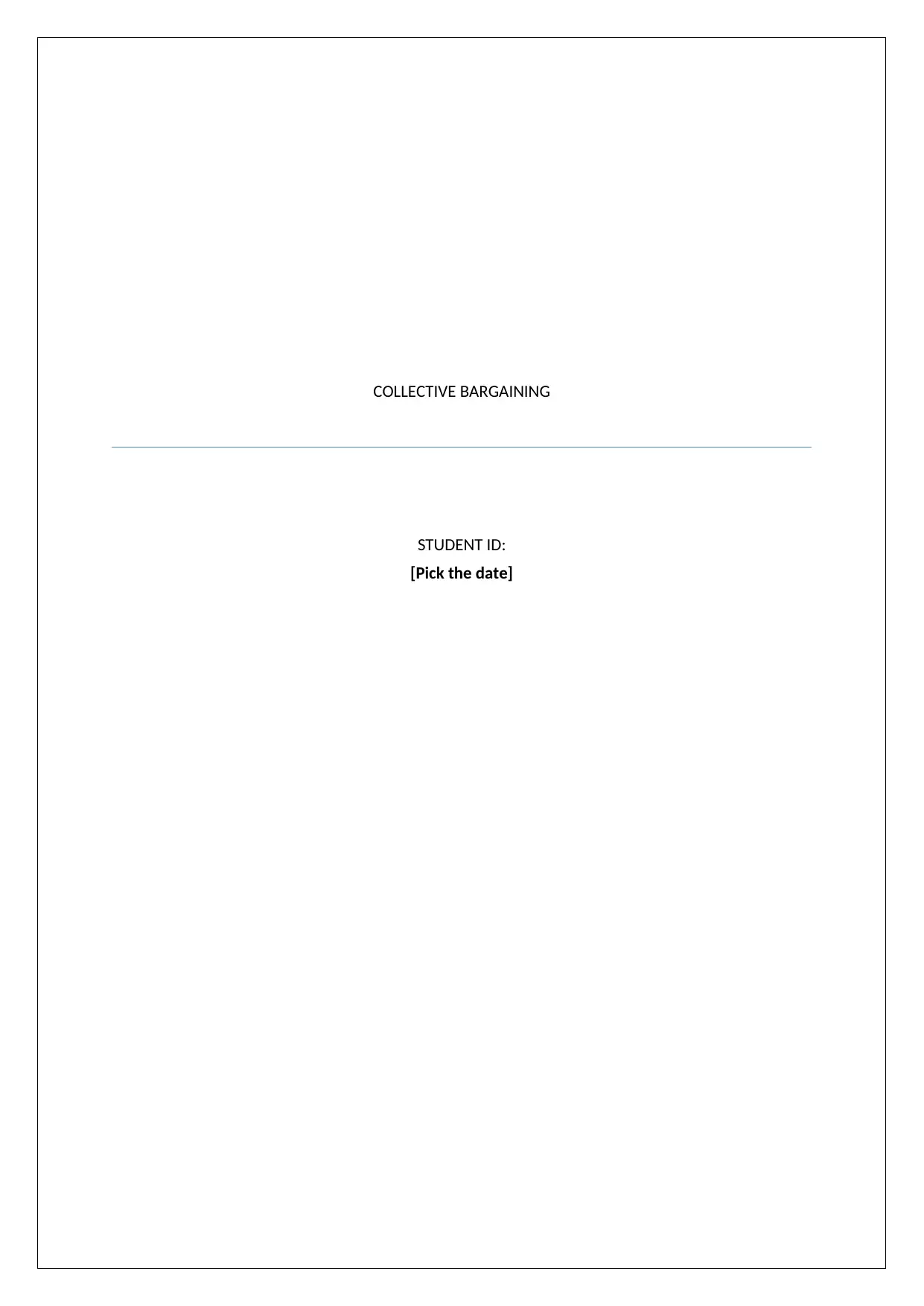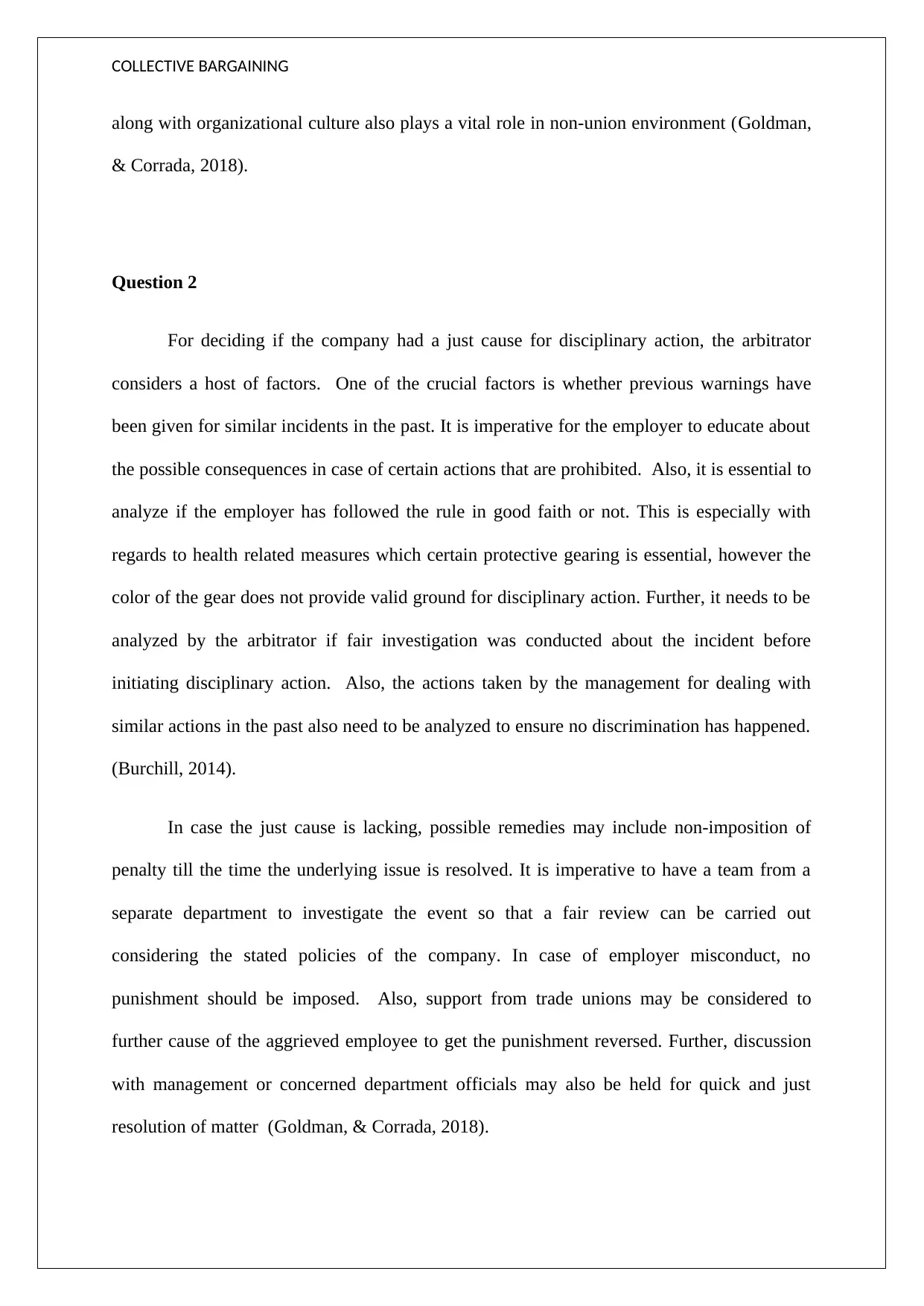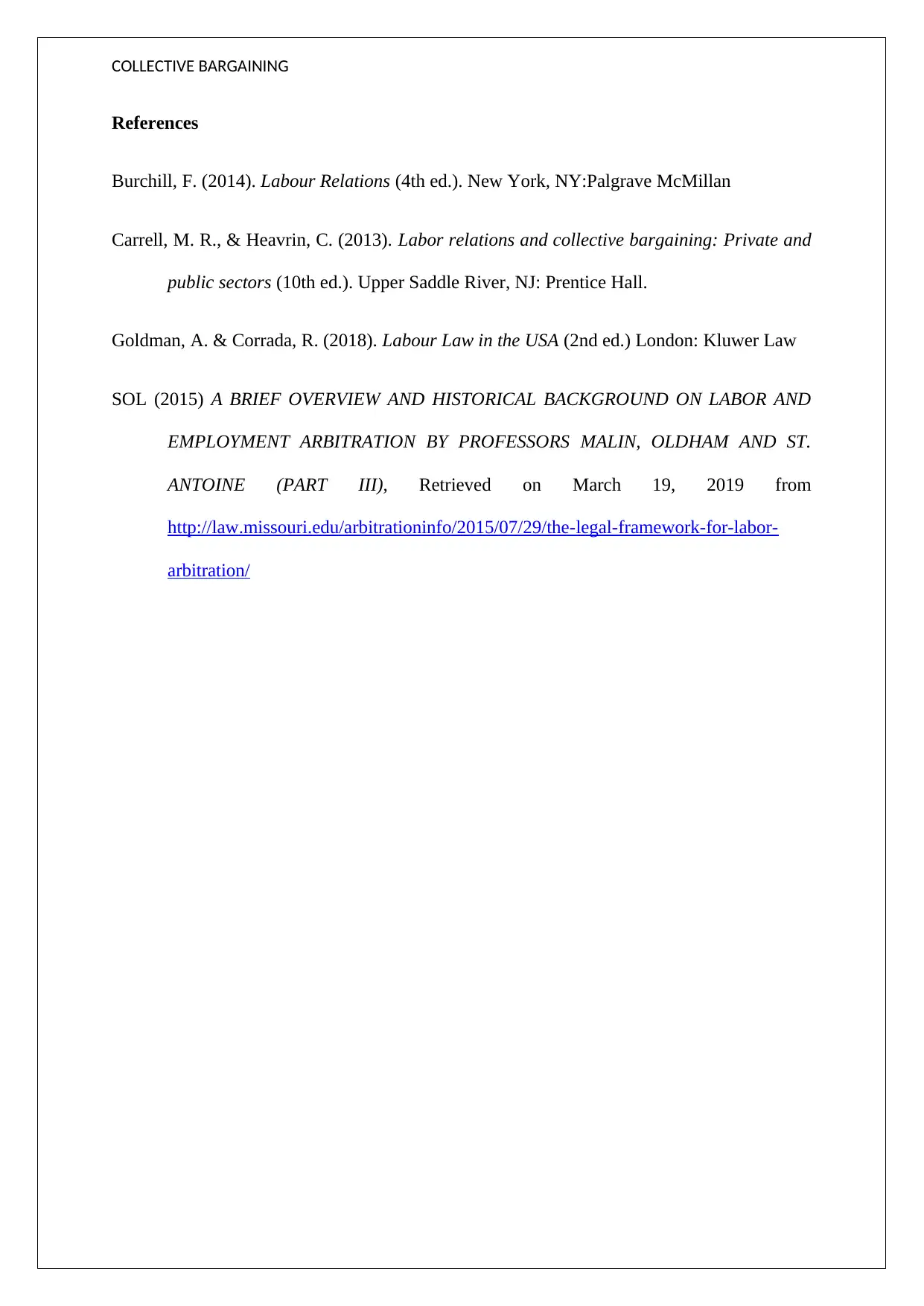Analyzing Enforcement of Collective Bargaining and Dispute Resolution
VerifiedAdded on 2023/04/07
|5
|794
|480
Essay
AI Summary
This essay discusses the enforcement of collective bargaining agreements through arbitration, highlighting the principles established in the Steelworkers Trilogy. It examines how arbitrators determine just cause for disciplinary action, considering factors like prior warnings, fair investigation, and consistent application of rules. The essay contrasts union and non-union environments, emphasizing the importance of company policies, employment laws, and organizational culture. Furthermore, it explores remedies for unjust disciplinary actions and alternative dispute resolution methods in the absence of union representation. Desklib offers more resources for students, including past papers and solved assignments.

COLLECTIVE BARGAINING
STUDENT ID:
[Pick the date]
STUDENT ID:
[Pick the date]
Paraphrase This Document
Need a fresh take? Get an instant paraphrase of this document with our AI Paraphraser

COLLECTIVE BARGAINING
Question 1
The collective bargaining agreements are enforced through the use of arbitration. The
broad principles with regards to labour arbitration have been outlined in the landmark
Supreme Court cases referred to as Steelworkers Trilogy. These essentially refer to the three
cases involving Steelworkers in 1960 in US (SOL, 2015).
One of the key principles highlighted is that arbitration is a contractual matter and
hence arbitration is not necessary if there is not an agreement to submit arbitration on a given
dispute. Another principle highlighted is that if there is any ambiguity with regards to
agreement of a party to arbitrate, the court needs to decide the same. However, in instances
where it is clearly stated that the given matter would not be subject to arbitration, then the
court cannot intervene regarding the same (Burchill, 2014). The third principle states that the
merits of any claim made under the collective bargaining agreement is to decided by the
arbitrator and not the court even if the underlying claim may seem frivolous. The fourth
principle relates to the labor contracts where there is presence of arbitration clause. In such
contracts, there is “presumption of arbitrability” unless a positive assurance exists which
indicates that the underlying arbitration clauses are not prone to interpretation whereby the
dispute is covered. Any doubts ought to be resolved in coverage favor. The fifth principle
relates to translation of labor agreement where mediator is not bound by the agreement
expressions. The mediator is free to consider external variables such as customary law, past
practice along with parole proof (Carrell & Heavrin, 2013).
In case of non-union environment, bargaining is typically done in accordance to the
company policies with regards to various aspects of employment. Also, a key role in this
regards is played by the various employment laws which are implemented by Federal as well
as state government so as to ensure the welfare of employees. The attitude of management
Question 1
The collective bargaining agreements are enforced through the use of arbitration. The
broad principles with regards to labour arbitration have been outlined in the landmark
Supreme Court cases referred to as Steelworkers Trilogy. These essentially refer to the three
cases involving Steelworkers in 1960 in US (SOL, 2015).
One of the key principles highlighted is that arbitration is a contractual matter and
hence arbitration is not necessary if there is not an agreement to submit arbitration on a given
dispute. Another principle highlighted is that if there is any ambiguity with regards to
agreement of a party to arbitrate, the court needs to decide the same. However, in instances
where it is clearly stated that the given matter would not be subject to arbitration, then the
court cannot intervene regarding the same (Burchill, 2014). The third principle states that the
merits of any claim made under the collective bargaining agreement is to decided by the
arbitrator and not the court even if the underlying claim may seem frivolous. The fourth
principle relates to the labor contracts where there is presence of arbitration clause. In such
contracts, there is “presumption of arbitrability” unless a positive assurance exists which
indicates that the underlying arbitration clauses are not prone to interpretation whereby the
dispute is covered. Any doubts ought to be resolved in coverage favor. The fifth principle
relates to translation of labor agreement where mediator is not bound by the agreement
expressions. The mediator is free to consider external variables such as customary law, past
practice along with parole proof (Carrell & Heavrin, 2013).
In case of non-union environment, bargaining is typically done in accordance to the
company policies with regards to various aspects of employment. Also, a key role in this
regards is played by the various employment laws which are implemented by Federal as well
as state government so as to ensure the welfare of employees. The attitude of management

COLLECTIVE BARGAINING
along with organizational culture also plays a vital role in non-union environment (Goldman,
& Corrada, 2018).
Question 2
For deciding if the company had a just cause for disciplinary action, the arbitrator
considers a host of factors. One of the crucial factors is whether previous warnings have
been given for similar incidents in the past. It is imperative for the employer to educate about
the possible consequences in case of certain actions that are prohibited. Also, it is essential to
analyze if the employer has followed the rule in good faith or not. This is especially with
regards to health related measures which certain protective gearing is essential, however the
color of the gear does not provide valid ground for disciplinary action. Further, it needs to be
analyzed by the arbitrator if fair investigation was conducted about the incident before
initiating disciplinary action. Also, the actions taken by the management for dealing with
similar actions in the past also need to be analyzed to ensure no discrimination has happened.
(Burchill, 2014).
In case the just cause is lacking, possible remedies may include non-imposition of
penalty till the time the underlying issue is resolved. It is imperative to have a team from a
separate department to investigate the event so that a fair review can be carried out
considering the stated policies of the company. In case of employer misconduct, no
punishment should be imposed. Also, support from trade unions may be considered to
further cause of the aggrieved employee to get the punishment reversed. Further, discussion
with management or concerned department officials may also be held for quick and just
resolution of matter (Goldman, & Corrada, 2018).
along with organizational culture also plays a vital role in non-union environment (Goldman,
& Corrada, 2018).
Question 2
For deciding if the company had a just cause for disciplinary action, the arbitrator
considers a host of factors. One of the crucial factors is whether previous warnings have
been given for similar incidents in the past. It is imperative for the employer to educate about
the possible consequences in case of certain actions that are prohibited. Also, it is essential to
analyze if the employer has followed the rule in good faith or not. This is especially with
regards to health related measures which certain protective gearing is essential, however the
color of the gear does not provide valid ground for disciplinary action. Further, it needs to be
analyzed by the arbitrator if fair investigation was conducted about the incident before
initiating disciplinary action. Also, the actions taken by the management for dealing with
similar actions in the past also need to be analyzed to ensure no discrimination has happened.
(Burchill, 2014).
In case the just cause is lacking, possible remedies may include non-imposition of
penalty till the time the underlying issue is resolved. It is imperative to have a team from a
separate department to investigate the event so that a fair review can be carried out
considering the stated policies of the company. In case of employer misconduct, no
punishment should be imposed. Also, support from trade unions may be considered to
further cause of the aggrieved employee to get the punishment reversed. Further, discussion
with management or concerned department officials may also be held for quick and just
resolution of matter (Goldman, & Corrada, 2018).
⊘ This is a preview!⊘
Do you want full access?
Subscribe today to unlock all pages.

Trusted by 1+ million students worldwide

COLLECTIVE BARGAINING
The process would be different in case union representation is not there. The starting
point would be the code of conduct which should be widely communicated and put up at
different places so that employees are aware about the same. It is imperative that dedicated
seminars should be held with regards to the code of conduct and resolving relevant queries
that employees may have. Also, the company should aim for standards which are higher than
the minimum standards imposed by the government. Further, arbitrator may be appointed in
certain cases to resolve the employer-employee disputes (Carrell & Heavrin, 2013).
The process would be different in case union representation is not there. The starting
point would be the code of conduct which should be widely communicated and put up at
different places so that employees are aware about the same. It is imperative that dedicated
seminars should be held with regards to the code of conduct and resolving relevant queries
that employees may have. Also, the company should aim for standards which are higher than
the minimum standards imposed by the government. Further, arbitrator may be appointed in
certain cases to resolve the employer-employee disputes (Carrell & Heavrin, 2013).
Paraphrase This Document
Need a fresh take? Get an instant paraphrase of this document with our AI Paraphraser

COLLECTIVE BARGAINING
References
Burchill, F. (2014). Labour Relations (4th ed.). New York, NY:Palgrave McMillan
Carrell, M. R., & Heavrin, C. (2013). Labor relations and collective bargaining: Private and
public sectors (10th ed.). Upper Saddle River, NJ: Prentice Hall.
Goldman, A. & Corrada, R. (2018). Labour Law in the USA (2nd ed.) London: Kluwer Law
SOL (2015) A BRIEF OVERVIEW AND HISTORICAL BACKGROUND ON LABOR AND
EMPLOYMENT ARBITRATION BY PROFESSORS MALIN, OLDHAM AND ST.
ANTOINE (PART III), Retrieved on March 19, 2019 from
http://law.missouri.edu/arbitrationinfo/2015/07/29/the-legal-framework-for-labor-
arbitration/
References
Burchill, F. (2014). Labour Relations (4th ed.). New York, NY:Palgrave McMillan
Carrell, M. R., & Heavrin, C. (2013). Labor relations and collective bargaining: Private and
public sectors (10th ed.). Upper Saddle River, NJ: Prentice Hall.
Goldman, A. & Corrada, R. (2018). Labour Law in the USA (2nd ed.) London: Kluwer Law
SOL (2015) A BRIEF OVERVIEW AND HISTORICAL BACKGROUND ON LABOR AND
EMPLOYMENT ARBITRATION BY PROFESSORS MALIN, OLDHAM AND ST.
ANTOINE (PART III), Retrieved on March 19, 2019 from
http://law.missouri.edu/arbitrationinfo/2015/07/29/the-legal-framework-for-labor-
arbitration/
1 out of 5
Related Documents
Your All-in-One AI-Powered Toolkit for Academic Success.
+13062052269
info@desklib.com
Available 24*7 on WhatsApp / Email
![[object Object]](/_next/static/media/star-bottom.7253800d.svg)
Unlock your academic potential
Copyright © 2020–2025 A2Z Services. All Rights Reserved. Developed and managed by ZUCOL.





